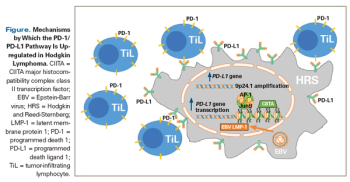
Patients with AML or MDS with unfavorable risk cytogenetic profiles, TP53 mutations, or both had good clinical response and robust mutation clearance with decitabine.

Your AI-Trained Oncology Knowledge Connection!



Patients with AML or MDS with unfavorable risk cytogenetic profiles, TP53 mutations, or both had good clinical response and robust mutation clearance with decitabine.

A high-risk subtype of acute lymphoblastic leukemia first identified in children appears to be highly prevalent in adults with ALL and is associated with a poor outcome.

The use of radiotherapy may have an important role in optimizing first-line treatment for patients with early-stage extranodal natural killer/T-cell lymphoma.

According to a long-term follow-up analysis of a phase I/II trial, bosutinib provides durable responses and a favorable toxicity profile in patients with chronic phase CML who are resistant/intolerant to other tyrosine kinase inhibitors.

The use of inpatient palliative care services among adult patients undergoing hematopoietic stem cell transplantation for a hematologic malignancy results in smaller decreases in quality-of-life outcomes compared with standard transplant care.

Patients with multiple myeloma may have improved tolerance of panobinostat when combined with low-dose thalidomide and subcutaneous bortezomib, according to the results of the phase I/II MUK-six trial.

This article describes the clinical data that led to approval of these B-cell receptor inhibitors for the treatment of CLL, and highlights newer agents in clinical development that target the same kinases as the currently available therapies.

Single-agent blinatumomab demonstrated antileukemia activity in pediatric patients with relapsed or refractory B-cell precursor acute lymphoblastic leukemia (BCP-ALL) in a recently published phase I/II study.

Although ibrutinib-related atrial fibrillation (IRAF) occurs in up to 11% of patients in clinical trials, these studies have rarely fully characterized bleeding events or risk factors for bleeding when ibrutinib is combined with anticoagulation. Furthermore, guidelines do not provide direction regarding the preferred anti-arrhythmic agent for IRAF.

Several critical issues need to be addressed during the next several years if we are to reach the true potential of new agents like ibrutinib, idelalisib, venetoclax, ofatumumab, and obinutuzumab-which conceivably could ultimately cure CLL.

Expression levels of CD62L and related immunologic markers are correlated with treatment responses and outcome in patients with CML, according to a new analysis. The markers could have prognostic value if validated in other cohorts.

The combination of ATRA and arsenic trioxide for the treatment of low- or intermediate-risk acute promyelocytic leukemia had advantages compared with ATRA plus chemotherapy.

A study found that deregulation of homeobox transcription factor genes underlies a subtype of precursor B-cell acute lymphoblastic leukemia.

Medical researchers at Indiana University Bloomington are reporting that prostate cancer may be much more closely related to Ewing’s sarcoma than previously recognized.

Researchers discover that CCL3-receptor antagonists could help control the development of leukemia in patients with Noonan syndrome

Treatment at a facility with a higher patient volume was associated with a lower risk of mortality for patients with multiple myeloma, even after adjustment for sociodemographic and geographic factors and comorbidities.

Patients with chronic myeloid leukemia with a history of prior malignancies generally fare as well as those without such a history, according to a new study.

One of the complications of multiple myeloma, a malignancy of plasma cells in the bone marrow, includes bone fractures and/or spinal cord compression. But a new treatment may offer bone protection to mitigate these issues.

Chronic infection with hepatitis B or C virus was associated with an increased risk for non-Hodgkin lymphoma among patients with HIV who are on antiretroviral therapy.

A new collaboration among industry, nonprofit, academia, and the federal government may lead to a change in the treatment paradigm for acute myeloid leukemia.

Maintenance therapy with norethandrolone significantly improved survival in elderly patients with acute myeloid leukemia without increasing toxicity.

An analysis of tyrosine kinase inhibitor initiation and adherence in Medicare beneficiaries with chronic myeloid leukemia suggests that out-of-pocket costs may be a barrier to treatment.

When CML patients develop resistance or intolerance to these drugs, transplant may be the only option.

Frontline intensive therapy with rituximab plus high-dose sequential chemotherapy did not improve outcomes for high-risk patients with DLBCL compared with treatment with R-CHOP-14.

In this article we review the scientific rationale, preclinical evidence, and most recent clinical data for the use of checkpoint inhibitor therapy in patients with relapsed Hodgkin lymphoma.